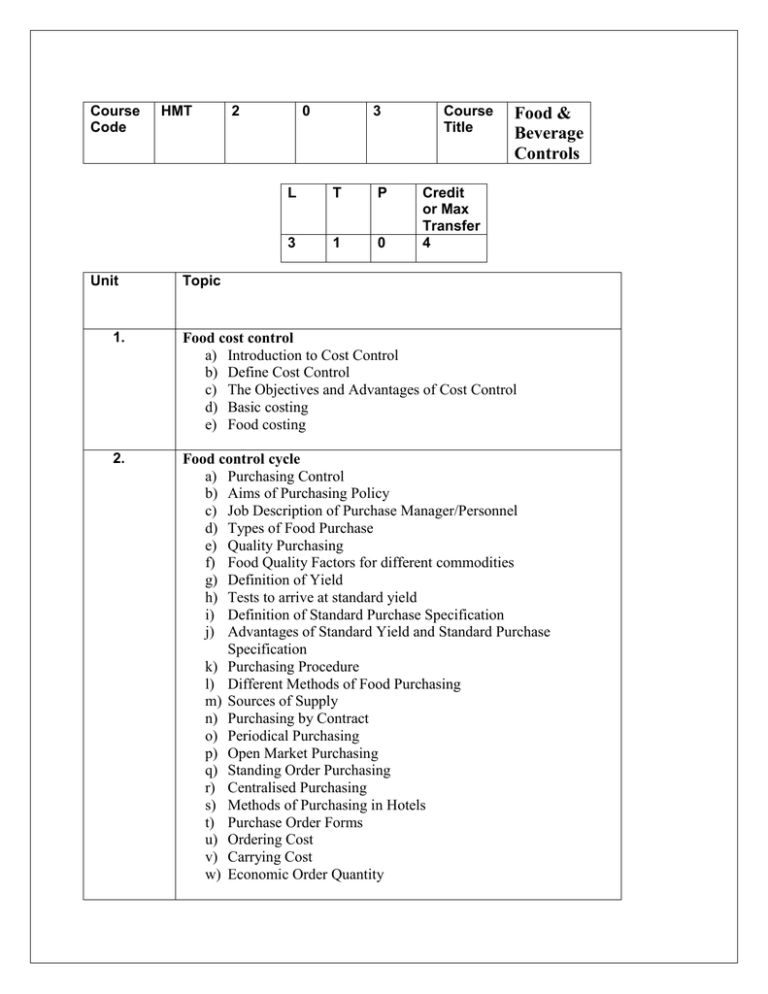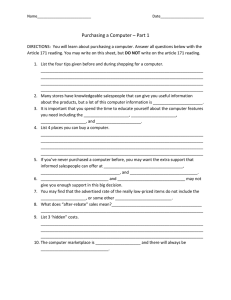Food & Beverage Controls
advertisement

Course Code Unit HMT 2 0 3 L T P 3 1 0 Course Title Food & Beverage Controls Credit or Max Transfer 4 Topic 1. Food cost control a) Introduction to Cost Control b) Define Cost Control c) The Objectives and Advantages of Cost Control d) Basic costing e) Food costing 2. Food control cycle a) Purchasing Control b) Aims of Purchasing Policy c) Job Description of Purchase Manager/Personnel d) Types of Food Purchase e) Quality Purchasing f) Food Quality Factors for different commodities g) Definition of Yield h) Tests to arrive at standard yield i) Definition of Standard Purchase Specification j) Advantages of Standard Yield and Standard Purchase Specification k) Purchasing Procedure l) Different Methods of Food Purchasing m) Sources of Supply n) Purchasing by Contract o) Periodical Purchasing p) Open Market Purchasing q) Standing Order Purchasing r) Centralised Purchasing s) Methods of Purchasing in Hotels t) Purchase Order Forms u) Ordering Cost v) Carrying Cost w) Economic Order Quantity 3. Receiving control a) Aims of Receiving b) Job Description of Receiving Clerk/Personnel c) Equipment required for receiving d) Documents by the Supplier (including format) e) Delivery Notes f) Bills/Invoices g) Credit Notes h) Statements i) Records maintained in the Receiving Department j) Goods Received Book k) Daily Receiving Report l) Meat Tags m) Receiving Procedure n) Blind Receiving o) Assessing the performance and efficiency of receiving department p) Frauds in the Receiving Department q) Hygiene and cleanliness of area 4. Storing & issuing control a) Storing Control b) Aims of Store Control c) Job Description of Food Store Room Clerk/personnel d) Storing Control e) Conditions of facilities and equipment f) Arrangements of Food g) Location of Storage Facilities h) Security i) Stock Control j) Two types of foods received – direct stores (Perishables/non perishables) k) Stock Records Maintained Bin Cards (Stock Record Cards/Books) l) Issuing Control m) Requisitions n) Transfer Notes o) Perpetual Inventory Method p) Monthly Inventory/Stock Taking q) Pricing of Commodities r) Stock taking and comparison of actual physical inventory and Book s) Value t) Stock levels 5. u) Practical Problems v) Hygiene & Cleanliness of area Production control a) Aims and Objectives b) Forecasting c) Fixing of Standards d) e) f) g) Definition of standards (Quality & Quantity) Standard Recipe (Definition, Objectives and various tests) Standard Portion Size (Definition, Objectives and equipment used) Standard Portion Cost (Objectives & Cost Cards) h) Computation of staff meals 6. Sales control a) Sales – ways of expressing selling, determining sales price, Calculation of selling price, factors to be considered while fixing selling price b) Sales concepts – Various sales concepts & their Use c) Billing procedure – cash and credit sales d) Procedure of cash Control i. ii. iii. iv. 7. 8. Machine System (ECR, NCR, Preset Machines, POS) Various Reports Cash Handling Procedures Thefts Beverage control i. Purchasing ii. Receiving iii. Storing iv. Issuing v. Bar Frauds vi. Books Maintained vii. Beverage Control Cost Dynamics i. Cost & Cost Accounting ii. Element of Cost iii. Classification of Cost Textbook: 1. Andrews Sudhir, F & B Service Training Manual, Tata Mc Grawhill, New Delhi 2007 2. Sharma Anita, Bagchi S.N, Food & beverage service, Aman Publication New Delhi ,2006 Additional Readings 1. Dave Broom, Sprits & cocktails, Poli books Pvt. Ltd. 2004 2. Denis lillicrap, Jon cousins, Food & beverage service 2008 NOTE FOR THE PAPER SETTER The syllabus has been divided into three units. Paper setter will set 3 questions from each unit and 1 compulsory question spread over the whole syllabus consisting of 5 short answer questions. Compulsory question will be placed at number one. Candidate shall be required to attempt 6 questions in all including compulsory question and selecting not more than 2 questions from each unit. All questions carry equal marks.




